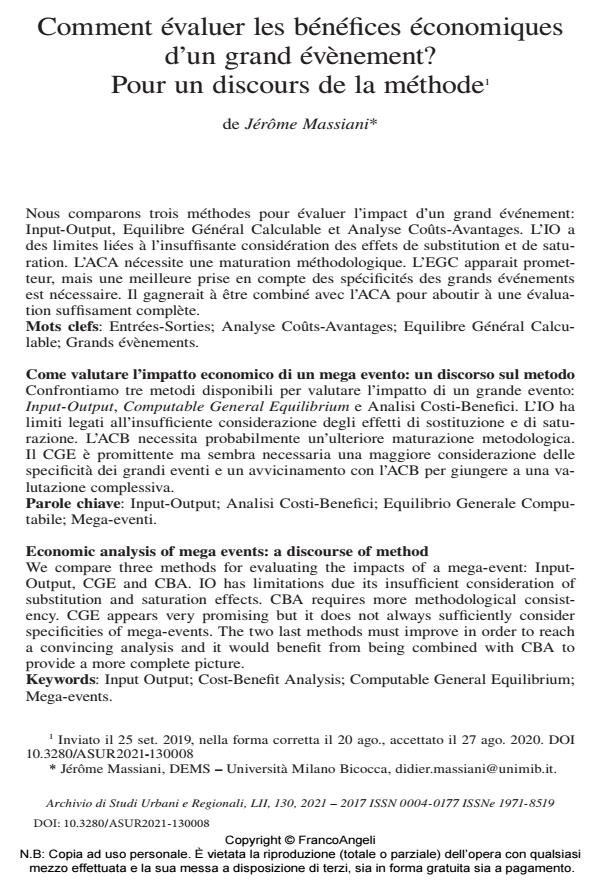Comment évaluer les bénéfices économiques d’un grand évènement? Pour un discours de la méthode
Titolo Rivista ARCHIVIO DI STUDI URBANI E REGIONALI
Autori/Curatori Jérôme Massiani
Anno di pubblicazione 2021 Fascicolo 2021/130
Lingua Francese Numero pagine 23 P. 140-162 Dimensione file 5820 KB
DOI 10.3280/ASUR2021-130008
Il DOI è il codice a barre della proprietà intellettuale: per saperne di più
clicca qui
Qui sotto puoi vedere in anteprima la prima pagina di questo articolo.
Se questo articolo ti interessa, lo puoi acquistare (e scaricare in formato pdf) seguendo le facili indicazioni per acquistare il download credit. Acquista Download Credits per scaricare questo Articolo in formato PDF

FrancoAngeli è membro della Publishers International Linking Association, Inc (PILA)associazione indipendente e non profit per facilitare (attraverso i servizi tecnologici implementati da CrossRef.org) l’accesso degli studiosi ai contenuti digitali nelle pubblicazioni professionali e scientifiche
Nous comparons trois méthodes pour évaluer l’impact d’un grand événement: Input-Output, Equilibre Général Calculable et Analyse Coûts-Avantages. L’IO a des limites liées à l’insuffisante considération des effets de substitution et de saturation. L’ACA nécessite une maturation méthodologique. L’EGC apparait prometteur, mais une meilleure prise en compte des spécificités des grands événements est nécessaire. Il gagnerait à être combiné avec l’ACA pour aboutir à une évaluation suffisament complète. Mots clefs: Entrées-Sorties; Analyse Coûts-Avantages; Equilibre Général Calculable; Grands évènements.
Confrontiamo tre metodi disponibili per valutare l’impatto di un grande evento: Input-Output, Computable General Equilibrium e Analisi Costi-Benefici. L’IO ha limiti legati all’insufficiente considerazione degli effetti di sostituzione e di saturazione. L’ACB necessi-ta probabilmente un’ulteriore maturazione metodologica. Il CGE è promittente ma sembra necessaria una maggiore considerazione delle specificità dei grandi eventi e un avvicina-mento con l’ACB per giungere a una valutazione complessiva.
Parole chiave:Input-Output; Analisi Costi-Benefici; Equilibrio Generale Computabile; Mega-eventi.
- Computable General Equilibrium assessment of mega-events: Issues and possible solutions Jérôme MASSIANI, in Journal of Policy Modeling /2022 pp.920
DOI: 10.1016/j.jpolmod.2022.09.015
Jérôme Massiani, Comment évaluer les bénéfices économiques d’un grand évènement? Pour un discours de la méthode in "ARCHIVIO DI STUDI URBANI E REGIONALI" 130/2021, pp 140-162, DOI: 10.3280/ASUR2021-130008